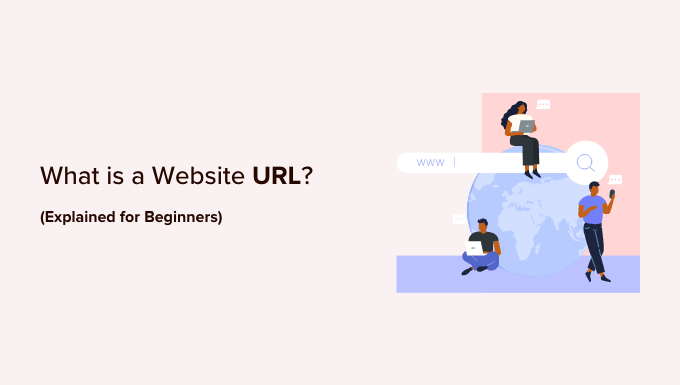[ad_1]
Recently one of our readers asked what is a website URL, and is it different from a domain name?
A URL is simply the address of a website on the internet. It is made up of a domain name, along with some other elements such as subdomains or subdirectories. Whether your URL has these other parts will depend on the choices you make when installing WordPress.
In this article, we’ll explain what is a website URL, describe the main parts that make up a URL, and show you how to choose and register a domain name for your website.
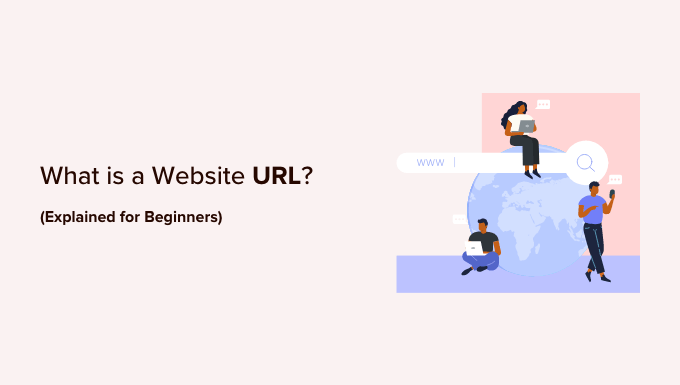
What Is a Website URL?
Every website is uniquely identified by a URL, or uniform resource locator. In simple terms, if you think of your WordPress website as a house, then the URL would be its address.
Every post, page, image, product, and resource on your website also has a unique URL. These are formed by adding characters after the website URL.
For example, the URL to a WordPress post looks like this:
There are three important parts of a URL. It starts with the protocol used to connect to the website, which will be HTTP or HTTPS. These days, you will mostly see HTTPS because it is more secure.
After that comes the domain name that identifies the website itself, and then the path to a specific post or resource on your website.
A URL may also contain other information, such as a subdomain or subdirectory, a query or other parameters, and an anchor to a specific part of a web page.
With that being said, let’s take a closer look at the 3 main parts that make up a URL, along with some optional elements:
1. The HTTP or HTTPS Protocol
The first part of a URL is the protocol. This identifies the set of rules that will be used to transfer information between the server and the user’s browser. The protocol used for websites is HTTP or HTTPS.
The protocol is followed by a colon and two forward slashes, like this:
HTTP stands for ‘hypertext transfer protocol’. This protocol is a set of rules that allow the user’s web browser to communicate with your website.
HTTPS stands for ‘hypertext transfer protocol secure’ and is used when the website is operating over a secure connection. This is especially important if you wish to collect payments on your website.
Users don’t need to type the protocol when entering your website’s URL into their web browser. These characters will be added automatically.
Should My Website Use a Secure HTTPS Connection?
Every day we share our personal information with different websites whether it’s making a purchase or simply logging in. In order to protect the data transfer, a secure connection needs to be created. That’s where HTTPS comes in.
HTTPS is an encryption method that secures the connection between users’ browsers and your server. This makes it harder for hackers to eavesdrop on the connection.
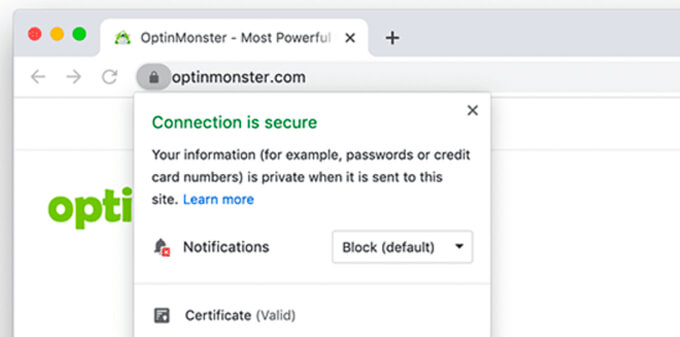
If you want to accept payments online on your eCommerce website, then you need to use HTTPS. That’s because most payment companies like Stripe, PayPal Pro, and Authorize.net require a secure connection before accepting payments.
But we encourage everyone to move their website from HTTP to HTTPS immediately, even if you don’t run an online store. That’s because Google ranks websites using HTTPS higher than those using HTTP.
Also, Google displays a ‘Not Secure’ warning when you visit an HTTP website in Chrome. When your users see this notice, it gives them a bad impression of your business.
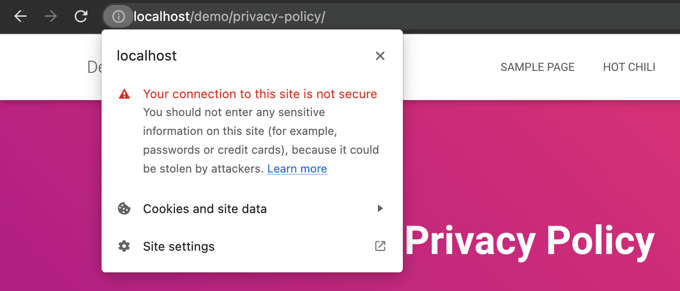
How Can I Move My Website to a Secure HTTPS Connection?
When you’re ready to set up a secure HTTPS connection for your website, you need to purchase an SSL certificate. SSL stands for ‘Secure Sockets Layer’ and is the standard technology for keeping an internet connection secure.
You may already be paying for an SSL certificate with your web hosting since many of the best WordPress hosting companies offer them free for all their users. For more details, see our guide on how to get a free SSL certificate for your WordPress website.
After you have enabled the SSL certificate on your domain name, you will need to set up WordPress to use SSL and HTTPS protocols on your website.
We show you how to do that step-by-step in our beginner’s guide on how to properly move WordPress from HTTP to HTTPS.
2. Your Website’s Domain Name
The second important part of a website URL is the domain name. This is the address that internet users type in their web browsers to visit your website, like this:
The user’s web browser will automatically add the correct protocol.
You need to choose a domain name when you first create your website. You should make sure that it’s easy to remember and not already being used by another website.
Once you’ve chosen your domain name, you will need to register it. This involves a small fee that you will need to pay to the domain registrar you choose.
What Are the Different Parts of a Domain Name?
A domain name is made up of two or three parts:
The top-level domain (TLD) is the extension of your domain name such as .com, .org, .net. There are other TLDs, but they are less common and we don’t recommend them.The second-level domain (SLD) refers to the name that comes before the top-level domain or TLD. For example, for our website, ‘wpbeginner’ is the second-level domain and ‘.com’ is the top-level domain.Some websites also use a ‘country code top-level domain’ or ccTLD to target their local audience. These include .uk for the United Kingdom, .de for Germany, and .in for India.
We always recommend using the .com domain extension because most users will remember your website’s name and assume that it ends in .com. You can learn more in our guide on whether you should choose a new domain extension for your website.
What’s the Difference Between a Domain Name and Hosting?
When you first create a website, you need both a domain name and web hosting. Many beginners are not sure what the difference is.
We said that a domain name is like the address that helps visitors find your house. Well, hosting is like the house itself. It is the place where your website posts, pages, images, and other resources actually live.
For a more detailed explanation, please take a look at our guide on the difference between a domain name and web hosting.
How Can I Choose the Best Domain Name for My Website?
Choosing the right domain name for your website is crucial for your success. Get it right the first time because changing it later is difficult and can hurt your brand and search rankings.
Try to make it short and easy to remember. Ideally, it should be less than 15 characters. It should be easy to spell and pronounce, otherwise, users might make a mistake when typing it and will see an error message or be taken to the wrong website.
If you are having trouble coming up with a good domain name, you might like to use a domain name generator. These free tools automatically search for your defined keywords to find hundreds of clever domain name ideas.
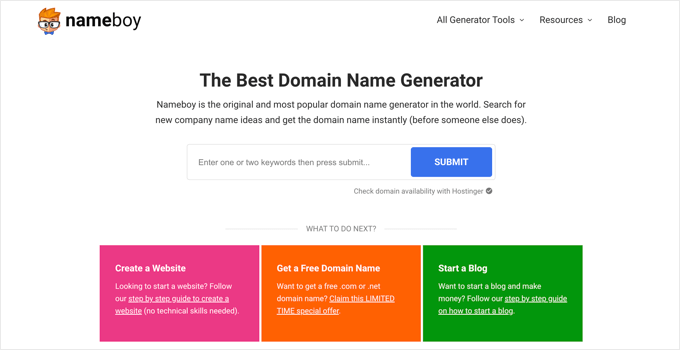
We recommend using Nameboy, which is one of the oldest and most popular domain name generator tools online.
You can also use WPBeginner’s free Business Name Generator tool, or IsItWP’s domain generator to find more domain name ideas.
For more tips and tools, see our guide on how to choose the best domain name.
Where Should I Register My Domain Name?
Once you choose a domain name, you will need to register it with a reputable domain registrar. These are companies accredited by ICANN (Internet Corporation for Assigned Names and Numbers) that allow you to purchase and register domain names.
All domain name records are stored in a centralized database. For a domain name to be recognized, it needs to be added to that database with all related information about it.
In our research, the best domain registrar is Domain.com if you’re just buying a domain name, or Bluehost if you’re looking to build a website because they give you a domain name for free.
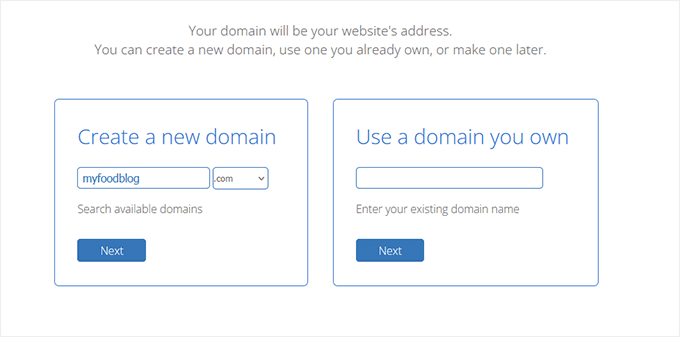
To learn what to watch out for and see other options, refer to our guide on how to choose the best domain name registrar.
Can I Change My Website’s Domain Name?
We mentioned earlier that it is difficult to change your website’s domain name, but it is not impossible. However, it needs to be done with care, or it will badly impact your SEO rankings.
Even when done carefully, changing your site’s domain name will temporarily affect your search engine rankings since Google and other search engines will need to adjust to the changes. It will also temporarily affect your search traffic.
The good news is that it is possible to dramatically minimize the impact and quickly regain your search traffic and rankings. You will need to notify Google and your users of the change and use an SEO plugin like All in One SEO to set up a full site redirect.
You can learn how to do this step-by-step by following our guide on how to easily move WordPress to a new domain without losing SEO.
3. The Path to a Specific Webpage
Your domain name will take visitors straight to your website’s homepage. But what if they want to visit a certain post or page? This is done by adding the path to that page in the URL after the domain name, like this:
In WordPress, these are called permalinks, and the part of the address that appears after the domain name is called the slug.
Ideally, a permalink should be easy for both humans and search engines to understand. When done right, they will help your posts rank higher on search engine results pages.
That means you should avoid permalinks like these:
How Can I Create an SEO-Friendly URL Structure in WordPress?
One of the benefits of using WordPress for your website is that it creates an SEO-friendly URL structure by default. This wasn’t always the case.
WordPress permalinks now use the post name by default. This is the most SEO-friendly URL structure because it is readable by both humans and search engines, and contains keywords that explain the article.
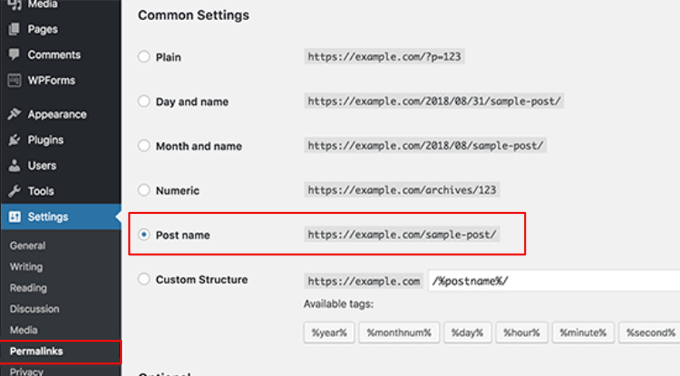
To learn more on this subject, see our guide on SEO-friendly URL structures in WordPress.
Can I Create Custom Permalinks in WordPress?
Some of our readers are interested in creating custom permalinks, so they have more control over the URLs used on their WordPress website.
Aside from changing the main permalink structure, WordPress also offers ways to customize the individual URLs of posts, pages, categories, tags, and other areas of your website.
You can also use WordPress plugins to create completely custom permalinks for specific sections of your website that override the default WordPress settings.
You can learn how in our ultimate guide on how to create custom permalinks in WordPress.
Should I Use a URL Shortener to Make Long Post URLs Easier to Share?
Sharing your web content on social media can build user engagement and bring new users to your website. But pasting in long links or URLs isn’t always the best way.
That’s why URL shortener services like Bitly and TinyURL were originally created. They take a long link and make it shorter so that it doesn’t take up as much space.
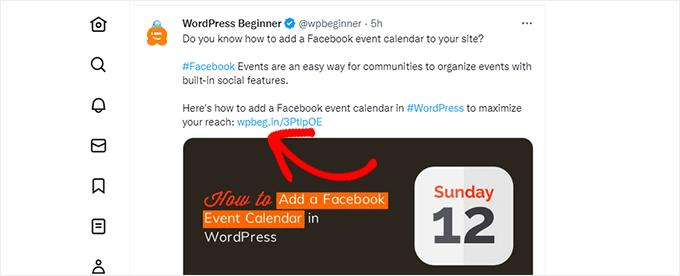
You can learn how to do this on your own website by following our guide on how to create a short link in WordPress.
On WPBeginner, we use a custom domain, wpbeg.in, for our short links, which is a bit more technical to set up and would require you to purchase another domain. We have a separate tutorial on how to create your own customized short URL.
Optional Parts of a Website URL
We’ve just taken a look at the 3 important parts that make up a website URL: the protocol, domain name, and permalink.
However, there are also several optional parts that can be used in a web address. Let’s have a look at the main ones now, and why you might like to use them.
Should You Include ‘www’ in Your Website URL?
You may have noticed that many website URLs start with ‘www’, and wonder whether there is an SEO benefit when you include it.
The fact is, there are absolutely no SEO benefits of using ‘www’ or not using it. You can choose whichever you prefer.
What is important is that you don’t change your mind after starting your website.
You can learn more in our guide on www vs non-www, which is better for WordPress SEO?
Why Do Some Businesses Install WordPress in a Subdomain or Subdirectory?
Some businesses want to create several websites under the same domain name. One way to do this is by using a subdomain, which places a word before your domain name like this:
You can create as many subdomains as you like, or choose not to use them at all. For example, some businesses use different subdomains for their blog and online store, such as https://blog.example.com and https://store.example.com.
Another way to create multiple websites on the same domain is to install WordPress in different subdirectories, like this.
The difference is that Google sees subdomains as separate websites and subdirectories as part of the same website. That means that search engines will rank your subdomains separately, while your SEO ranking will be shared between your domain and subdirectories.
For bloggers, startups, or small businesses with limited time and resources, using subdirectories will help you rank your website faster than using a subdomain.
You can learn more in our step-by-step guide on how to install WordPress in a subdirectory.
Some users accidentally install WordPress in a subdirectory. This happens when they install WordPress manually and copy the actual ‘wordpress’ folder instead of its contents onto their website. Their website URL will look like this:
You can learn how to fix this error in our guide on how to get rid of /wordpress/ from your WordPress site URL.
Can a URL Take Users Directly to a Section of a Post or Page?
Finally, you can add some characters to the end of a URL to help users quickly jump to the section of a post they want to read. These are called ‘anchor links’, and are formed by adding a hash character and anchor after the permalink like this:
You can learn how and when to use anchor links in our guide on how to easily add anchor links in WordPress.
We hope this tutorial helped you learn more about website URLs. You may also want to see our guide on how to keep your WordPress site secure, or our expert picks on the best social media plugins for WordPress.
If you liked this article, then please subscribe to our YouTube Channel for WordPress video tutorials. You can also find us on Twitter and Facebook.
The post What is a Website URL (Important Parts Explained for Beginners) first appeared on WPBeginner.
[ad_2]
Source link
